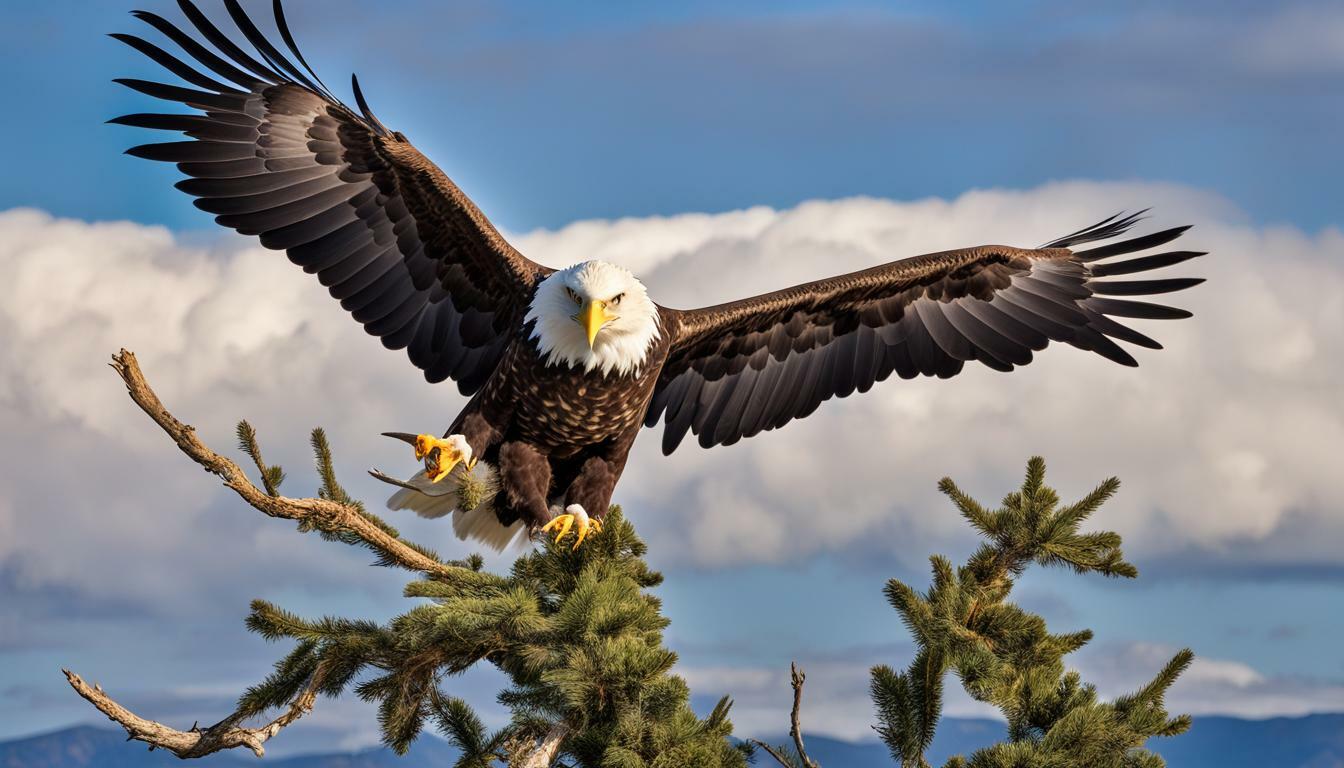Have you ever wondered if bald eagles screech? These magnificent birds are known for their sharp talons and impressive wingspan, but their vocalizations are just as fascinating. Many people associate the bald eagle with a piercing screeching noise, but is it true?
In this article, we’ll explore the sounds that bald eagles make, including their typical call and the iconic screeching sound. We’ll also delve into the mechanics of how they produce these sounds and the purpose behind their vocalizations. You’ll learn about their range of calls, songs, and duetting, as well as the importance of understanding their sounds from a conservation standpoint.
Key Takeaways:
- Bald eagles do indeed screech, but they make a variety of other sounds as well.
- Their vocalizations serve several purposes, such as establishing territory and communicating with their young.
- The study of bald eagle sounds is crucial for conservation efforts and monitoring the health of their populations.
Understanding Bald Eagle Sounds
Have you ever heard a bald eagle’s call? These majestic birds are known for their iconic screeching sound, but did you know that they also make other vocalizations?
The typical call of a bald eagle is a series of high-pitched whistles, usually heard during the breeding season. However, when people refer to the “eagle screech,” they are often talking about the piercing, descending call that is associated with these birds.
But why do bald eagles make these sounds?
The Meaning and Purpose of Bald Eagle Sounds
Like many animals, bald eagles use vocalizations to communicate with each other. The screeching sound that they are known for is used for a variety of purposes, including:
- Establishing territory: Bald eagles screech to let other eagles know that they are in a particular area and that it belongs to them.
- Attracting mates: During the breeding season, male eagles will engage in an elaborate display of aerial acrobatics and vocalizations to attract females.
- Communicating with young: Bald eagles use a variety of vocalizations to communicate with their young, including soft chirps and whistles to encourage them to eat or fly.
- Signaling warnings: When threatened or disturbed, bald eagles will often emit a loud, harsh call to alert other eagles to the danger.
While the screeching call is perhaps the most recognizable, bald eagles are actually capable of producing a wide range of sounds. They can whistle, chirp, and trill, and even engage in duetting and singing during courtship rituals.
But how do these birds create such powerful and distinctive sounds?
How Do Bald Eagles Screech?
Bald eagles are known for their piercing and powerful screeching calls. But how exactly do they produce this sound?
It all starts with the unique vocal adaptations of these birds. Bald eagles have a specialized syrinx, which is the vocal organ located at the base of their trachea. This syrinx allows them to produce a variety of sounds, including the screeching noise that they are most famous for.
In addition to their specialized syrinx, bald eagles also use their powerful lungs to create their calls. They take in a large amount of air before forcing it through their syrinx, creating a high-pitched and far-reaching sound that can be heard from great distances.
It’s worth noting that not all bald eagle calls are screeches. They also produce a range of other vocalizations, such as chirps, whistles, and trills. But their screeching call is perhaps the most recognizable and impressive of all.
The Purpose of Screeching in Bald Eagles
Bald eagles are known for their distinct screeching noise, but have you ever wondered why they make this sound? Screeching is just one of the many vocalizations that bald eagles use to communicate with other eagles and establish their presence in their habitat.
The screech of a bald eagle can be heard from up to a mile away and serves multiple purposes. One of the main reasons bald eagles screech is to establish territory and ward off potential threats. By emitting a loud and piercing call, they let other eagles know that the area is already occupied and that they should stay away.
Another reason bald eagles screech is to attract mates and communicate with their young. During courtship, they engage in elaborate vocal displays to impress their potential partners, showcasing their vocal abilities and physical prowess. Once they have offspring, they use vocalizations to communicate with them and teach them how to survive and thrive in their environment.
Finally, bald eagles also use screeching as a warning signal to other eagles about potential danger, such as the presence of predators or human activity. This helps them protect their young and stay safe in their habitat.
Overall, the screeching noise of bald eagles serves as an important form of communication and plays a vital role in their survival and success as a species.
Other Vocalizations of Bald Eagles
While bald eagles are often associated with their piercing screech, they are actually capable of a wide range of vocalizations. These include whistling, chirping, and trilling, each with its own unique sound and purpose.
One of the most common calls of bald eagles is a series of clear whistles, used for communication between mates and during courtship displays. These calls are typically short and high-pitched, with a rising and falling pitch pattern.
Chirping is another sound that bald eagles use to communicate with their young or signal their presence to other eagles. Typically, these chirps are short and relatively quiet, but they can also be used to alert other eagles to danger.
Trilling is another vocalization that bald eagles use, particularly during courtship displays. These melodious calls involve a series of rising and falling notes, which can be highly complex and varied.
Overall, bald eagles are highly communicative birds, using a variety of calls and vocalizations to establish their territory, signal warnings, and bond with their mates and offspring. Their vocal abilities are a testament to their intelligence and adaptability, making them one of the most remarkable species of bird in North America.
Bald Eagle Songs and Duetting
When it comes to communication, bald eagles are much more than one-trick ponies. In addition to their screeching calls, they also use songs and duetting as a form of expression, particularly during courtship rituals and bonding.
During these displays, bald eagles engage in elaborate musical conversations, with each partner taking turns to create a series of chirps, trills, and whistles. These duets not only strengthen their pair bonding but also work as a tool for defense of their nesting territory.
Interestingly, bald eagles don’t sing the same song every year. Instead, they create new melodies that are entirely unique to each breeding season, adding complexity to their vocal abilities.
Bald Eagle Songs and Duetting
“Bald Eagles have a wide variety of calls that we’re still learning about. They have the ability to make some beautiful sounds.”
- Eagles have a musical ear, and their songs sound very much like high-pitched gull caws.
- Bald Eagles are one of the few species that engages in duetting. Eagles are well known for their incredible bond with their partner and this is reflected in their duetting behavior.
The complex and lyrical vocalizations of bald eagles are truly a marvel to behold, reminding us of the beauty and power of nature.
The Importance of Eagle Sounds in Conservation
Understanding the vocalizations of bald eagles plays a crucial role in their conservation. Researchers use audio recordings to monitor and study population trends, track migration patterns, and identify individual birds. In addition, eagle sounds serve as an early indicator of environmental stressors, such as pollution or habitat loss.
By analyzing the frequency, pitch, and volume of these sounds, researchers can determine the health and well-being of eagle populations. For example, changes in the vocalizations of nesting pairs can signal breeding success or failure, allowing conservationists to evaluate the effectiveness of management strategies.
Furthermore, eagle vocalizations have cultural significance, serving as symbols of national pride and American identity. Protecting these birds and their unique vocal abilities is a testament to our commitment to preserving the natural world.
So, by expanding our knowledge of eagle sounds and their importance in conservation, we can ensure the survival of these majestic creatures for generations to come.
Factors Affecting Bald Eagle Vocalizations
While bald eagles are known for their distinctive screeching noise, various factors can affect their vocalizations. These factors can include age, sex, geographic location, and environmental conditions.
Young eagles, for example, may have different vocalizations than adult eagles, while male and female bald eagles can have slightly different calls. Additionally, eagles that live in different regions may have varying vocalizations, potentially due to genetic differences or environmental pressures.
The environment can also impact the sounds that bald eagles make. For example, eagles may alter their calls to communicate over long distances in noisy or windy environments. They may also modify their vocalizations to attract mates during breeding season or communicate with their young.
Furthermore, researchers have found that bald eagles can adjust their calls in response to threats or changes in their surroundings. For instance, eagles may produce unique warning calls to alert others in their group of the presence of predators or intruders.
Overall, understanding the different factors that influence bald eagle vocalizations is essential for comprehending their behaviors and communication patterns. By studying the variations in their vocalizations, researchers can gain valuable insights into the lives and well-being of these majestic birds.
Captivating Facts about Bald Eagle Vocalizations
So, you already know that bald eagles screech, but did you know that…
- Their vocal range is incredible, with some calls reaching over a mile away!
- Bald eagles are named after the Old English word “balde”, which means “white-headed”.
- In Native American culture, bald eagle feathers are considered sacred and are only to be worn by the most distinguished members of the tribe.
- Bald eagles have a unique trilling call that sounds like a laugh or chuckle.
- They can also mimic other birds and even human speech!
“If we can teach people about wildlife, they will be touched. Share my wildlife with me. Because humans want to save what they love.” – Steve Irwin
Bald eagles have captivated human interest and admiration for centuries, and their vocalizations only add to their charm and majesty. Understanding their sounds is essential to appreciating these iconic birds and preserving their habitat.
Conclusion
Congratulations, you now know that bald eagles do indeed screech! Their screeching sound is just one of many vocalizations that these majestic birds are capable of making. By understanding their sounds, you can gain a deeper appreciation for the complexity of their communication methods and the level of intelligence they possess.
Studying and monitoring bald eagle vocalizations is critical to their conservation and protection. By identifying their calls, researchers can track their populations and better understand their behaviors and movements. So the next time you hear a bald eagle screech, take a moment to appreciate the power and beauty of their voice.
Are Bald Eagles’ Angry Appearance Related to Their Screeching Sound?
Are bald eagles’ angry appearance related to their screeching sound? Many people wonder why bald eagles appear angry when they screech. The truth is, their intimidating and fierce expression is not connected to their vocalizations. The screeching sound serves as a means of communication, allowing them to establish territory, attract mates, and signal danger. Understanding the reason behind why bald eagles appear angry can debunk misconceptions about their temperament.
Can Bald Eagles Contract Rabies if they Screech?
Bald eagles and rabies: separating facts and myths. Although bald eagles may emit screeching sounds, they cannot contract rabies. As top predators, their immune system protects them from the virus. While it’s crucial to dispel misinformation, understanding the complexities of wildlife health is essential in preserving and respecting these majestic birds.
FAQ
Q: Do bald eagles screech?
A: Yes, bald eagles do screech. They are known for their powerful and piercing vocalizations that can be heard from a distance.
Q: What does the screeching sound of bald eagles mean?
A: The screeching sound of bald eagles serves various purposes. It can be a territorial display, a call to attract mates, a form of communication with their young, or a warning signal to other eagles.
Q: Can bald eagles make other sounds besides screeching?
A: Yes, bald eagles can produce a range of vocalizations. Besides screeching, they can whistle, chirp, trill, and engage in elaborate songs and duetting during courtship rituals.
Q: How do bald eagles produce their screeching sound?
A: Bald eagles have unique vocal adaptations that allow them to create their screeching sound. These adaptations include specialized vocal muscles, a large syrinx (the vocal organ in birds), and the ability to control the shape and tension of their vocal cords.
Q: Is studying bald eagle vocalizations important for their conservation?
A: Yes, understanding bald eagle vocalizations is crucial for their conservation. Researchers use these sounds to track and monitor eagle populations, and they serve as indicators of the health and well-being of these magnificent birds.
Q: What factors can affect bald eagle vocalizations?
A: Several factors can influence bald eagle vocalizations, including age, sex, geographic location, and environmental conditions. These factors can contribute to variations in their sounds.
Q: Are bald eagle vocalizations loud?
A: Yes, bald eagle vocalizations can be incredibly loud. Their screeching sound can carry over long distances and is often described as piercing and powerful.
Q: Are bald eagle vocalizations culturally significant?
A: Yes, bald eagle vocalizations hold cultural significance in many Native American tribes. Their calls are believed to have spiritual meanings and are revered as symbols of strength, freedom, and connection to the natural world.
Q: Can bald eagles screech underwater?
A: No, bald eagles cannot screech underwater as they primarily vocalize in the air. However, they can produce other sounds, such as splashing or flapping their wings, while in the water.







